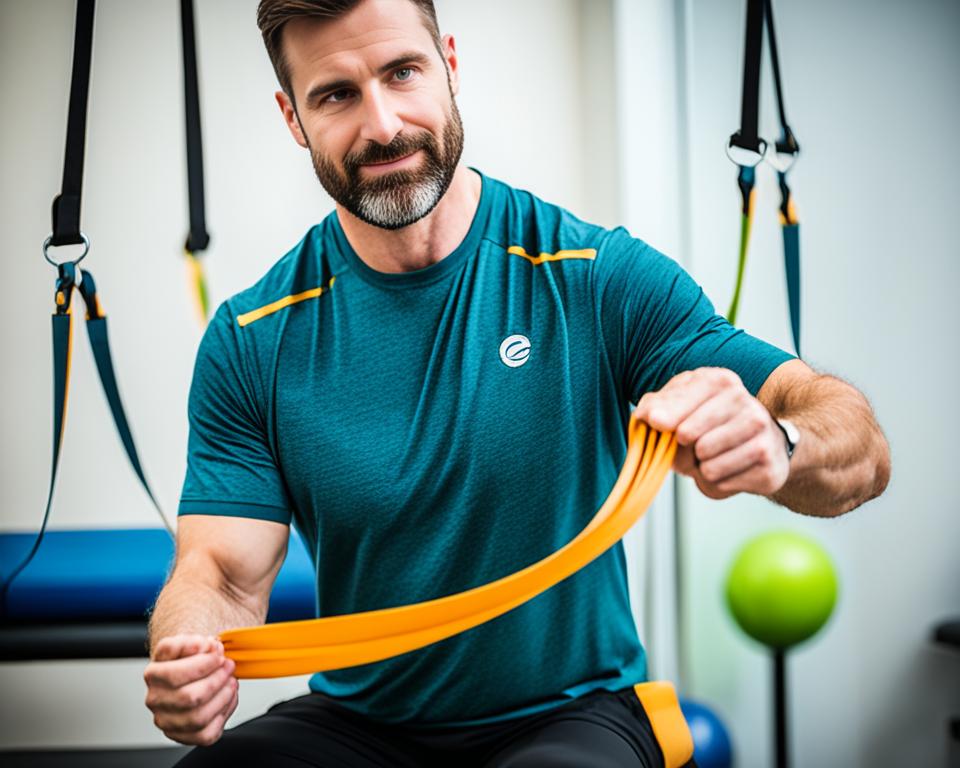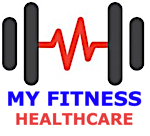Did you know stretching a resistance band can be a strength training hero? The CDC recommends them for building strength in workouts. These powerful strips have benefits we often miss.
Weights and treadmills are popular, but resistance bands do more than tone muscles. A Harvard Medical School study shows they help fight muscle loss, known as sarcopenia. Resistance bands are a safe way for muscles to grow stronger, especially as you age.
I want to show you the benefits of resistance bands for strength training. They’re not just workout tools; they improve life. They help with rehabilitation, posture, and even sleep quality.
Key Takeaways
- Resistance bands are endorsed by the CDC to increase strength and enhance full-body workouts.
- These bands are instrumental in improving flexibility, mobility and combating age-related muscle loss.
- Exercising with resistance bands can revitalize your back, shoulder, and core muscles for better posture and stability.
- They are not only effective for physical rehabilitation but also offer significant mental health benefits.
- Strength training with resistance bands has a positive impact on blood sugar management and may reduce the risk of prediabetes.
- Women who regularly engage in resistance workouts experience notable health benefits, including a lower risk of cardiovascular mortality.
- Engaging in just one hour of resistance band exercises can significantly enhance the quality of your sleep.
Exploring the Versatility of Resistance Bands
I’ve learned a lot about resistance band exercises benefits through my years of coaching. These tools have been changing bodies and boosting strength since the early 1900s. The positive effects are significant. Studies in the SAGE Open Medicine journal show that using these bands can boost strength like traditional weights can. And it’s great for everyone, from the young to the elderly. People of all ages can use resistance bands for physical therapy and building muscle, as research in the Archives of Gerontology and Geriatrics shows.
Using resistance bands to improve flexibility is something I strongly support, especially during warm-ups. Stretching first can really lower the chance of getting hurt. For those just starting out, these bands are a perfect first step into strength training. If you’re worried about keeping the right form, resistance bands help guide you while you learn tougher moves.
The Portability Factor: Fitness Anywhere, Anytime
The thing that really excites me is how easy it is to take resistance bands anywhere. You don’t need a gym; your living room, a hotel, or even a park can be where you work out. This gear easily fits into your lifestyle. They represent flexibility and convenience, letting anyone work out whenever and wherever they want.
Adapting Workouts for All Fitness Levels
When I train athletes of all levels, the versatility of resistance bands really stands out. They can be adjusted to fit anyone’s workout needs, making them more challenging or easier. They’re especially good for those overcoming injuries or dealing with aging, helping them move better and get stronger.
To wrap things up, we live in a time where we love tools that adapt to our complex lives. The resistance band is just that. It meets our need for tough workouts without sacrificing adaptability.
Amplifying Muscle Activation and Stabilization
Exploring the benefits of using resistance bands for fitness shows a big perk: more muscle work. These tools aren’t just handy—they make your muscles work harder. This is crucial for building a strong and stable body. People with low back pain find that core-focused exercises greatly ease their discomfort and improve muscle function.

Resistance bands boost muscle work by challenging our stabilizers. These are the muscles that support all our actions. By using the constant pull of the bands, I help my clients get stronger. They also gain better balance and core strength, doing so effectively and efficiently.
| Statistic | Data | Impact on Fitness |
|---|---|---|
| Clinical Lumbar Instability Prevalence | 15.7% in rice farmers with low back pain | Exercises like those with resistance bands are essential for core stabilization, reducing pain and disability. |
| Improvement Post-Stabilizing Exercises | Significant reduction in pain intensity | Reaffirms that stabilizing exercises, which can be conducted with bands, are beneficial for managing pain. |
| Lumbar Vertebral Instability Improvement | Patients show improvement in pain and disability | Core stability exercises, including band workouts, enhance muscle activation, aiding rehabilitation. |
| Skeletal Muscle Percentage in Body | Approximately 35% | High muscle engagement through resistance training is vital as it constitutes a significant portion of the body’s mass. |
| Average Skeletal Muscle Fibers in Biceps | About 253,000 fibers in young adult males | Shows the complexity and the vast potential for muscle activation within a single muscle. |
Using benefits of resistance bands for fitness greatly improves muscle health. It helps with back pain and activates many muscles. Remember, for all fitness levels, resistance bands make a big difference. They kick your muscle work and stability up a notch, changing how you exercise.
The Surprising Role of Resistance Bands in Fat Loss
Resistance bands do more than just add variety to workouts. They play a key role in losing fat, boosting your metabolism and making efforts to get trim more effective. Let’s dive into how these bands help keep calories burning long after your workout is done.
Understanding the ‘After-Burn’ Effect
Ever felt that awesome burn of calories long after your workout ends? That’s the ‘after-burn’ effect, or EPOC, and resistance bands crank it up. Using the bands keeps fat burning going, even when you’re resting.
Contributing to a Higher Metabolic Rate
Resistance bands are crucial for workouts because they help grow and maintain muscle. More muscle means a higher metabolic rate. So, keeping muscle lets you burn more calories, even when you’re just chilling.
| Health Outcome | Impact of Resistance Training | Additional Notes |
|---|---|---|
| Brain Health | Improved cognition and brain function | Especially beneficial for older individuals |
| Depression in Diabetes | 77% higher odds with type 2 diabetes, reduced with resistance training | Resistance training aids in mood improvement |
| Blood Sugar Control | Lower glucose and insulin levels post-training | Effective for those with or at risk of type 2 diabetes |
| Inflammation | Lower levels with more muscle mass | Correlates with stronger grip and knee extension |
Choosing resistance bands is about more than building muscle. It’s about embracing a key to overall wellness. I’m excited to help you explore their full potential. Let’s not just focus on getting toned but aim for a healthier life.
Hidden Benefits of Resistance Bands in Injury Prevention and Rehabilitation
As your guide in muscle building, I’ve seen amazing results with resistance bands for physical therapy. They stretch and push your muscles for gentle, yet powerful, workouts. For instance, a study by Behm et al. in 2010 showed these bands are great for the core muscles. These muscles are key not just in sports but for everyday actions too.
But, we must be careful with these exercises. Anderson and Behm in 2004 found that being unstable during workouts can lower your strength. Resistance bands help by keeping the tension without this drawback. Cowley et al. in 2007 also highlighted their use in sports health, showing how great they are for building strength.
Goodman et al. in 2008 confirmed that you don’t lose strength training on unstable surfaces. So, adding resistance bands to your workouts boosts strength without trouble. Let’s look at some research that shows how these tools help prevent injuries and aid in rehab:
| Study | Focus | Findings |
|---|---|---|
| Hamlyn et al. (2007) | Trunk muscle activation | Significant activation during dynamic and isometric instability exercises |
| Baechle et al. (2008) | Resistance training essentials | Outlined crucial elements for effective strength and conditioning training |
| Behm et al. (2009) | Traditional vs. Instability resistance training | Explored effects on strength, balance, and functional performance |
| Colado et al. (2011) | Paraspinal muscle recruitment | Intensive muscle recruitment not solely based on instability |
| Vera-Garcia et al. (2009) | Core muscle activity | Variations observed for dynamic resistance exercises based on surface stability |
| Abenhaim et al. (2000) | Activity’s role in managing back pain | Highlighted effective therapeutic approaches for back pain management |

Training with resistance bands for physical therapy doesn’t just target the main muscles. It also fixes muscle imbalances, which often cause injuries. For those into strength training, using resistance band benefits for strength training during recovery keeps you going. This way, you avoid the stress from regular gym gear.
Enhancing Flexibility and Mobility for Long-Term Health
As a muscle-building mentor, I always emphasize the importance of flexibility and mobility. Resistance bands are great for more than just strength. They help improve flexibility too. By adding them to your workouts, you make your muscles stronger and more limber. This helps them work better and heal quicker.
Combatting Age-Related Muscle Deterioration
Using resistance bands regularly leads to amazing changes in your body. They boost levels of growth hormones and improve muscle function. This helps fight off muscle loss as you get older. It lays a strong foundation for staying flexible and enjoying a better life in the long run.
Targeted Stretches with Resistance Bands
Resistance bands are great for targeted stretches that improve flexibility. These stretches increase your range of motion. They are recommended by experts and help fight muscle loss. No matter your age, using resistance bands helps keep your body agile.
There are many reasons to use resistance bands in your workouts. They keep you healthy now and help you stay vibrant in the future. So, when you use a resistance band, think of it as investing in a future filled with flexibility and mobility.
Resistance Bands as a Tool for Better Sleep and Recovery
As a coach in muscle building, I’ve seen how resistance bands boost sleep quality. They work by changing the body’s hormonal reactions after workouts. Resistance training led to better sleep for many clients by making muscles slightly tired, which helps in getting a good night’s sleep. It’s amazing that a simple tool like a resistance band can greatly improve sleep.
The Link Between Resistance Training and Sleep Quality
Using resistance bands before bed does more than increase strength; it helps you sleep better. The American Heart Association found that people using resistance bands sleep longer and more soundly. Good sleep is key for recovery, fixing the body after a day’s hard work.
Hormonal Responses That Enhance Restorative Sleep
Working out with resistance bands affects how well you sleep. Dr. Nerina Ramlakhan pointed out an increase in muscle adenosine is crucial. This fact shows us that wearable sleep trackers are useful in checking our sleep and its influencing factors. Thus, making resistance bands a valuable tool for improving sleep.
FAQ
What are the hidden benefits of resistance bands for strength training?
Resistance bands are great for boosting muscle strength and tone. They work main and stabilizer muscles for better workouts. They also reduce injury risk, making them perfect for all fitness levels.
Why should I use resistance bands over traditional weights?
Resistance bands offer benefits that weights can’t match. They give constant muscle tension for diverse gains. Plus, they’re light and portable, so you can exercise anywhere with ease.
How does the versatility of resistance bands contribute to my workouts?
Resistance bands are great for all workout levels and types. They help improve flexibility, endurance, and aid in recovery. With bands, your workouts can become more varied and effective.
Can resistance bands improve my muscle activation? How?
Yes, they can. Resistance bands make your muscles work harder by providing steady tension. This activates main and secondary muscles, offering a more complete workout experience.
What is the ‘After-Burn’ effect and how do resistance bands play a role?
The ‘After-Burn’ effect boosts oxygen intake after hard workouts. Resistance band exercises can amplify this effect. It helps burn more calories even after your workout ends.
How do resistance bands aid in boosting my metabolic rate?
Working out with resistance bands builds lean muscle, boosting your metabolism. This helps your body burn calories all day, supporting weight loss and fat reduction over time.
Can resistance bands help in injury prevention and rehabilitation?
Absolutely. They’re key in physical therapy and rehab for their gentle strength-building. Resistance bands improve strength and mobility slowly, preventing and helping recover from injuries.
How do resistance bands combat age-related muscle deterioration?
Resistance band training fights muscle loss from aging, known as sarcopenia. It’s a safe way for the elderly to keep or gain muscle, ensuring independence and well-being.
What are the targeted stretches I can do with resistance bands to improve flexibility?
Resistance bands are perfect for enhancing flexibility through targeted stretches. They’re suitable for various stretching methods, ideal for warm-ups and recovery.
How can resistance training with bands lead to better sleep?
Resistance training raises adenosine levels, helping you sleep better. Band workouts tire you out, leading to deeper sleep cycles for muscle repair and recovery.
What hormonal responses are associated with resistance band training that enhance restorative sleep?
Training with bands can boost hormones like growth hormones, aiding muscle recovery and sleep quality. These exercises promote relaxation and tiredness, leading to sound sleep.

